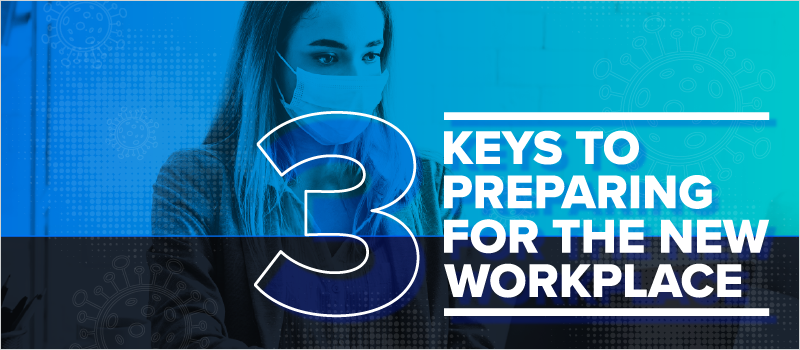
Are you ready to go back to the office?
Do your employees even want to go back to the office?
The working parents on your team with young kids at home might be dreaming of getting back to the relative peace of a structured office environment, while others might be stressing over the increased risk of exposure to COVID-19 and the possibility of carrying it to elderly family members or other high-risk individuals.
IBM Institute for Business Value (IBV) just released a survey detailing how U.S. adults’ personal behavior and preferences have shifted due to the COVID-19 pandemic. The study polled more than 25,000 U.S. adults in the month of April on how COVID-19 is influencing their perspectives on retail spending, transportation, future attendance at events in large venues, and returning to work.
The study results make it clear: Americans don’t want to go back to the office.
- 54% want remote work to be their primary way of working
- Over 75% said they would like to continue to work remotely at least occasionally
- Almost 40% indicated they feel strongly that their employer should provide employee opt-in remote work options when returning to normal operations
But is your organization prepared to make remote work a permanent part of your culture, rather than just a temporary reaction to an external situation?
As this Inc. article argues, there is a distinct difference between working from home for a day or two because you want a change of scenery and remote working long term.
Remote working permanently requires a different set of abilities, resources, and soft skills like time management, proactive communication, and a self-starting attitude. Even before so many professionals were working from home, a 2019 study from the IBV revealed that adaptability, time management, and ability to work well on teams are considered by CEOs to be some of the skills most crucial to the workforce today.
If you are considering making remote work a permanent option post-pandemic, it’s imperative that you start reskilling your employees around those abilities now.
Online learning offers an easy and safe way to provide your employees the training they need. Right now, we’re offering 20+ free remote work training courses to help your employees be more productive at home, communicate with other remote teammates, and stay healthy as we move to a “new normal.”
Some of the course titles include:
- Giving Clear Work Priorities
- Managing Rapid Change in Crisis
- Efficient & Impactful Remote Meetings
- A Rational Guide for Returning to the Post COVID-19 Workplace for Employers
- Cybersecurity: Working from Home
- Sweats to Suits
In addition to upskilling your employees with remote training, as you consider making a long term switch to perhaps staggered shifts in the office and more employees remote working, you’ll want to set some policies in place.
1. Strong Communication
This could include weekly email communications from management, frequent virtual town-hall meetings with leaders, and making sure employees know where to go with questions or problems. Remote work can be isolating, and it’s on both the employee and the employer to make an extra effort at connection and communication now.
At eLearning Brothers, instead of our monthly company-wide meeting with in-person presentations from each department head, we now have a slightly shorter weekly video call to bring all our employees together. We even did a company-wide virtual Jeopardy!® game at the end of the day one Friday.
In a survey done by Brandon Hall Group on how to respond to long-term HR challenges caused by COVID-19, HR professionals ranked their biggest concerns about productivity loss from remote workers:
- 71% distractions from home (chores/children/pets, etc.)
- 53% employees being less connected with their managers
- 36% employees not having the right hardware for their work
These are all manageable concerns.
Help employees understand what your expectations are and how you’ll be measuring productivity. In a more permanent remote work environment, will you expect your employees to be available within set working hours, or allow flexibility for them to complete work at the times they feel most productive? Answer these questions early on, before employees simply start acting on assumptions.
2. Equipment and Cybersecurity Policies
When this global work from home experience started, you may have signed up for free trials of every virtual conferencing and chat software out there. As you look to the future, decide which tools are working best for your organization and streamline and standardize on those.
Set clear guidelines on how to use company technology and equipment. Do you want employees taking equipment out of the corporate office to make their home offices work better, or would you rather just have them expense new equipment for home offices? It’s easy to lose track of company equipment in times like these.
You also open your company up to cyber attacks as employees start mixing personal and work devices and using different networks. The right training, and proactive communication from your IT department, can mitigate your cyber risk.
3. Reward Agility & Focus on Employee Well-Being
It’s important to remember that we are not going to be returning to work as it was before. We are transitioning to a new era of work, one that will require great flexibility, innovation, and adaptability.
Those employees who have adapted well to the new work environment and who have pivoted and helped your organization push forward deserve recognition. Otherwise, you risk damaging employee retention at a time when you need it most.
Ask yourself how those well-adjusted employees can help others who are struggling more with the change. Perhaps you can find a good social learning opportunity and a way to bring your remote workforce together. While many organizations emphasized employee well-being and safety at the start of this crisis, now is not the time to let up. Adjusting to this “new normal” of work will still require strength.
As you prepare for the next transition, take advantage of the resources many companies are sharing for free right now. One of the most positive things coming out of this crisis is the “we’re in this together” attitude we’re seeing across the training industry and beyond.
We shared some tips for bringing employees together for virtual games in the webinar May the Workforce Be With You and our free remote training includes mental health courses on managing stress, preventing overreactions, and other work from home tips.
If your employees are staying remote and you want to start delivering even more customized, interactive online training to them, we can help.
With the right training, the right tools, and the right support, your employees will be ready to conquer the new workplace and help your organization succeed.







